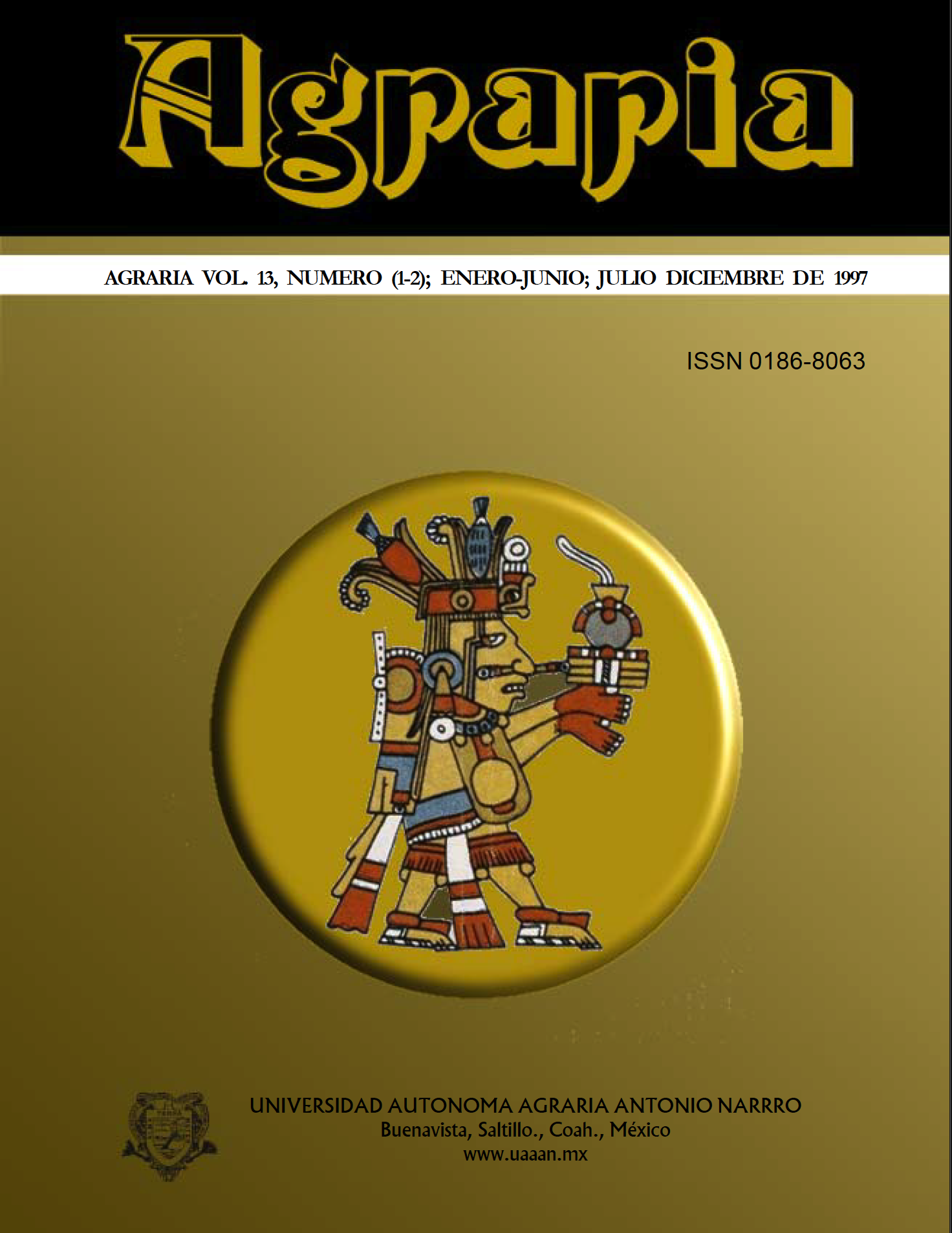Modo de reproducción y potencial forrajero de híbridos de Zacate buffel
DOI:
https://doi.org/10.59741/agraria.v13i1-2.222Keywords:
Cenchrus ciliaris L., progeny test, dry matter, apomixisAbstract
Apomixis is a barrier to the genetic improvement of many plants. Buffel grass (Cenchrus ciliaris L.) is an apomictic one and its breeding has been restricted to the ecotype selection method. However with the discovery of sexuality new breeding schemes have been proposed. From a progeny of 456 F, plants from the cross of the sexual clon TAM-CRD B-1s with the apomictic variety Z-115, 108 F1 hybrids were selected with the objetive of determining its reproduction mode and forage potential. Progeny tests were conducted at Ocampo, Coahuila in 1991 and 1992. The progenies were established transplanting 15 F plants per progeny with plants 1m apart within the row and rows 0.8m apart. Varieties Z-115 ard Common were included as controls. The reproduction mode was determined based on the uniformity of the progenies and dry matter yield as the average of three cuttings of forage. The mejority of the F, progenies were apomictic. The sexual to apomictic ratio was 1:9.8 respectively. The progeny tests proved to be an effective technique to determine the reproduction mode. The F2 progenies of the apomictic F, hybrids were more vigorous and outyielded dry matter production of the F, sexual hybrids F progenies. Eight F2 progenies from apomictic hybrids were superior in dry matter production to the mean yield plus the standard deviation of Z-115. The results showed that hybridizatior of the sex il clon with compatible apomictic males offers great possibilities of obtain ng superior pomictic genotypes.
Downloads
References
Bashaw, E.C. 1962. Apomixis and sexuality in buffel grass. Crop Sci. 2:412-415. DOI: https://doi.org/10.2135/cropsci1962.0011183X000200050015x
Problems and possibilities of apomixis in the improvement of tropical forage grasses. In: E.C. Doll and G.O. Mott, (ed.). TropicalForage in Livestock Production Systems. Am. Soc. Agron. Special Pub. No. 24 pp: 23-30.
Buffel grass. In: Grasses and Legumes in Texas: Development, production and utilization. Holt, E.C. and R.D. Lewis (eds.) Texas Agric. Exp. Sta. Texas A&M Univ. College Station.
and W.W. Hanna. 1990. Apomictic reproduction. In: Reproductive versatility in the grasses. G.P. Chapman (ed.). Cambridge University Press. pp: 100-130.
Briones R., M.A. 1991. Características de producción de semilla de 10 materiales de zacate buffel. Tesis de Licenciatura. Universidad Autónoma Agraria Antonio Narro, Buenavista, Saltillo, Coah., México. 57 pp.
Hanna, W.W. and E.C. Bashaw. 1987. Apomixis its identification and use in plant breeding. Crop Sci. 27: 1136-1139. DOI: https://doi.org/10.2135/cropsci1987.0011183X002700060010x
Ibarra F., J. R. Cox y M. Martín R. 1991. Efecto del suelo y clima en el establecimiento y persistencia del zacate buffel en México y sur de Texas. Pp:14-28. In: Séptimo Congreso Nacional SOMMAP. Simposium Internacional Aprovechamiento Integral del Zacate Buffel. Cd. Victoria Tamps. 20-30 agosto.
Osuna R., O. M. 1986. Buffel Zaragoza-115 para el norte de Coahuila. CAEZAR- CIAN-INIFAP-SARH. Delegación CAEZAR 1.
Poehlman, J.M. 1983. Mejoramiento genético de las cosechas. Octava Edición. Ed. Limusa., México, D.F. 453 pp.
Saldívar, F., A. 1991. Ecosistemas del zacate buffel en Tamaulipas. pp: 42-51. In: Séptimo Congreso Nacional SOMMAP. Simposium Internacional Aprovechamiento Integral del Zacate Buffel. C. Victoria, Tamps. 20- 23 agosto.
Taliaferro, C.M. and E.C. Bashaw. 1966. Inheritance and control of obligate apomixis in breeding buffel grass, Pennisetum ciliare. Crop Sci.. 6:476-376. DOI: https://doi.org/10.2135/cropsci1966.0011183X000600050025x
Downloads
Published
Issue
Section
License

This work is licensed under a Creative Commons Attribution-ShareAlike 4.0 International License.
How to Cite
PLUMX Metrics

